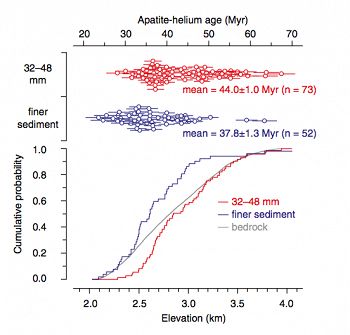Riebe et al., 2015
Climate and topography control the size and flux of sediment produced on steep mountain slopes
Riebe, C., Sklar, L., Lukens, C., and Shuster, D. (2015)
Proceedings of the National Academy of Sciences
-
Sierra, INVESTIGATOR
-
Sierra, GRAD STUDENT
Plain English Summary
Rivers carve through landscapes with sediment in streambeds that originally weathered from higher hillslopes. Both the size and supply rate of sediments influence the pace of river channel incision and landscape evolution. Riebe et al. are building scientific knowledge on these connections by quantifying the size distribution of sediment supplied from slopes. This study used a new approach to measure sediment forming by combining several existing sediment-tracing techniques. Results from their work in the High Sierra of California show that sediment size matters: colder, steeper, and less vegetated slopes produce coarser sediment that erodes faster into the channel network. And the results confirm that researchers can use this new approach to quantify feedbacks between climate, topography, and erosion.
Abstract
Weathering on mountain slopes converts rock to sediment that erodes into channels and thus provides streams with tools for incision into bedrock. Both the size and flux of sediment from slopes can influence channel incision, making sediment production and erosion central to the interplay of climate and tectonics in landscape evolution. Although erosion rates are commonly measured using cosmogenic nuclides, there has been no complementary way to quantify how sediment size varies across slopes where the sediment is produced. Here we show how this limitation can be overcome using a combination of apatite helium ages and cosmogenic nuclides measured in multiple sizes of stream sediment. We applied the approach to a catchment underlain by granodiorite bedrock on the eastern flanks of the High Sierra, in California. Our results show that higher-elevation slopes, which are steeper, colder, and less vegetated, are producing coarser sediment that erodes faster into the channel network. This suggests that both the size and flux of sediment from slopes to channels are governed by altitudinal variations in climate, vegetation, and topography across the catchment. By quantifying spatial variations in the sizes of sediment produced by weathering, this analysis enables new understanding of sediment supply in feedbacks between climate, tectonics, and mountain landscape evolution.
Citation
Riebe, C., Sklar, L., Lukens, C., and Shuster, D. (2015): Climate and topography control the size and flux of sediment produced on steep mountain slopes. Proceedings of the National Academy of Sciences. DOI: 10.1073/pnas.1503567112
Explore Further



